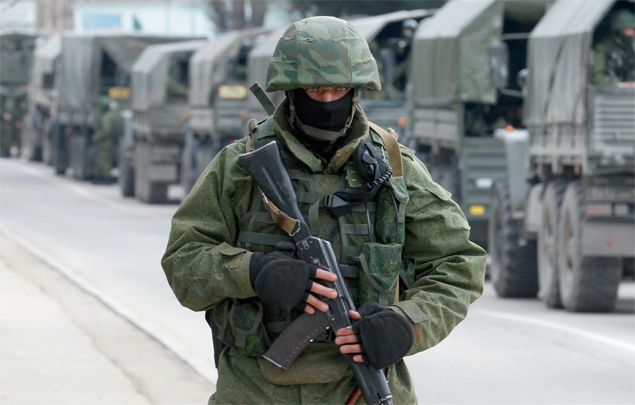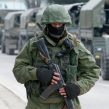
The Crimean Operation: Russian Force and Tactics
Publication: Eurasia Daily Monitor Volume: 11 Issue: 61
By:

The military aspect of Russia’s intervention in Crimea is coming to an end. On March 25, Vladimir Putin ordered the local “self-defense” forces to integrate into the regular Russian military and security forces (Interfax, March 25). Whereas, the Security and Defense Council of Ukraine resolved to withdraw the remaining Ukrainian troops from the peninsula. Reportedly, by March 26, Russian flags were flying over all 193 Ukrainian military facilities in Crimea (https://www.arms-expo.ru/050049054050124051053051054051.html).
The Russian operation to annex Crimea was remarkable in the way the forces were planned and assembled, including the state military, private military companies, paramilitary civilians, Ukrainian security personnel and Crimean police. At the initial pre-military stage of the operation, civilian protesters, assembled by pro-Russian parties such as Russkoye Yedinstvo, organized mass rallies in Crimean cities—such as the 50,000 protesters who gathered in Sevastopol in February. At this stage, operation managers started recruiting local “self-defense” forces and claimed that Sevastopol alone recruited 10,000 activists (https://www.mk.ru/politics/sng/article/2014/02/24/989562-raskolotyiy-poluostrov-kryim-stroit-samooboronu-ot-radikalov.html).
The core of the Russian occupation force was made up of elite mobile units: army intelligence (GRU) personnel, paratroopers, and probably the Federal Security Service (FSB). On February 26, troops from the Russian GRU Spetsnaz brigade from Togliatti and the paratroopers’ elite 31 Gvardeyskaya brigade from Ulianovsk were reportedly deployed to Crimea on Black Sea Fleet (BSF) vessels that returned from their mission of guarding the coast of Sochi (https://news.liga.net/news/politics/989450-v_krym_napravili_brigadu_spetsnaza_gru_rossii_smi.htm). The types of troops involved—Russia’s most elite units—suggest that the core Crimean force’s mission was specifically to capture military bases, disrupt Ukraine’s command and control channels, and put informational pressure on the adversary. They were also Russia’s most experienced units. The commander of the Ulianovsk brigade, Colonel Gennadiy Anashkin (awarded Hero of Russia) has commanded missions in Bosnia, the two Chechen wars, as well as the 2008 invasion of Georgia. Notably, Anashkin’s battalion tactical group took over the Vaziani Georgian base (https://www.1tv.ru/news/social/205987).
An investigative report by RBC quoted a Russian officer who identified himself as a paratrooper colonel. The officer explained that the mission of the Russian military was to blockade the Ukrainian units in Crimea and prevent them from re-deployment or removing their weapons from the peninsula. The Russian military was not given the order to use firearms, unless attacked first by armed opponents (https://top.rbc.ru/viewpoint/14/03/2014/911290.shtml). So in the absence of a timely evacuation order for the Ukrainian armed forces, the Russian military was able to seize all key strategic bases in Crimea.
Russian RBC further quoted a Black Sea Fleet source who revealed that the Russian troops in Crimea included representatives of the former Chechnya-based Vostok battalion as well as the 22nd GRU Separate Spetsnaz Brigade based in Krasnaya Polyana near Sochi. Furthermore, the Russian forces were apparently made up solely of contract soldiers (kontraktniki) and not conscripts. The soldiers reportedly were ordered to cede their personal documents and mobile phones prior to the mission (https://top.rbc.ru/politics/06/03/2014/909718.shtml).
In that way, the Russians were able to stage a “deniability” operation, at the center of which were the soldiers in brand new, insignia-less Russian uniforms—dubbed by Ukrainians as the “little green men.” On February 27, two groups comprised together of up to 120 insignia-less troops calling themselves “self-defense forces of the Russian-speaking Crimean citizens” seized the parliament and government buildings in Simferopol, the administrative capital of Crimea (https://www.pravda.com.ua/rus/news/2014/02/28/7016676/). These soldiers were initially perceived to be Russian troops, though, it is still possible that Crimean private security contractors supported by Russia might have been among these operators. The siege met no resistance from the local police and security guards, signifying that Kyiv had little control over the local Crimean police. Political expert Yevhen Magda has argued that it would have been possible for the central government in Kyiv to deploy elite SBU “Alpha” unit against the “little green men” on February 27–28, but nobody gave them such orders (Author’s interview, March 27).
Crimean “self-defense” forces may include personnel from Russian private security or military companies who act as the equivalent of “officers” in these units, according to military analyst Dmitry Tymchuk (https://www.facebook.com/dmitry.tymchuk?fref=ts). Several photos taken of the Crimean operation suggest that the Russian “battle group” includes contractors, or perhaps even private military personnel (https://niklife.com.ua/politics/42523). Remarkably, however, as part of Moscow’s propaganda campaign against Kyiv, the Russian media accused Ukraine of allegedly employing private American security company Greystone Limited to deal with separatists in Dnipropetrovsk and Donetsk (https://www.vedomosti.ru/politics/news/24423701/chastnaya-voennaya-kompaniya-greystone-limited-navedet?utm_source=vedomosti&utm_medium=widget&utm_campaign=vedomosti&utm_content=link).
Whether or not Russian security company personnel was placed in charge of the “self-defense” units in Crimea, the fact remains that the core of these armed formations was made up of less disciplined, former Ukrainian Berkut riot police from Crimea and reportedly some other Ukrainian oblasts, who were let go after Kyiv’s Maidan street battles. The new Crimean authorities incorporated Berkut officers into the peninsula’s security services, and the majority has already received Russian passports (https://112.ua/politika/v-krymu-kolichestvo-boycov-berkuta-uvelichitsya-do-800-chelovek-istochnik-38616.html). Other elements of the Crimean “self-defense” forces included Russian Cossacks from Kuban, who arrived in Crimea in mid-February (https://www.pravda.com.ua/rus/news/2014/03/14/7018794/?attempt=1). Apparently, local Crimean Cossacks were mobilized as early as mid-January when they had their “krug” assembly and, on January 18, declared an alliance with the Russkoye Yedinstvo (Russian Unity) party, headed by Crimean Prime Minister Sergei Aksenov (https://kazak.crimea.ua/news/view/?id=103). Indeed, all of the self-defense forces were reportedly linked to Crimea’s pro-Russian parties, foremost Russkoye Yedinstvo. This suggests a further link to the Ukrainian oligarchs: Espreso.tv reported that Dmytro Firtash “paid for Crimea’s capture,” implying that Firtash was financially backing Russkoye Yedinstvo (https://espreso.tv/article/2014/03/08/zakhvat_krymu_oplatyv_firtash).
Thus, the Russian takeover of Crimea had, essentially, a special-operations character, which involved strong political, informational and special services components. In fact, it was not until March 11, the Russian forces took up strong military defensive positions on the peninsula and deployed 22 artillery units at Perekop and Grad missiles at Dzhankoi (https://www.blackseanews.net/read/77613). It must be noted, however, that such an operation was only possible due to the lack of resistance by the Ukrainian forces—predicated specifically by the government’s weakness and tenuous political control over the Crimean peninsula.




